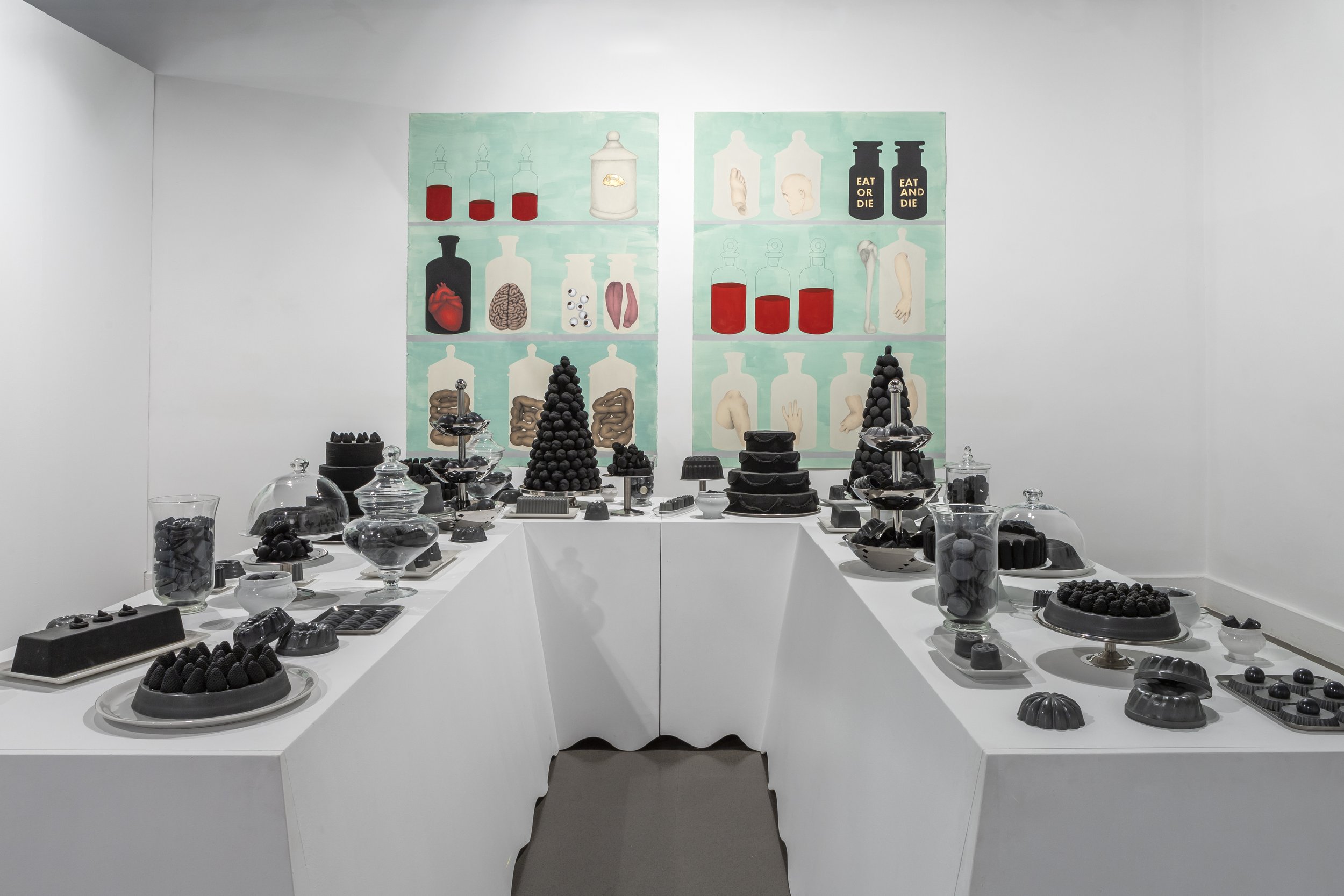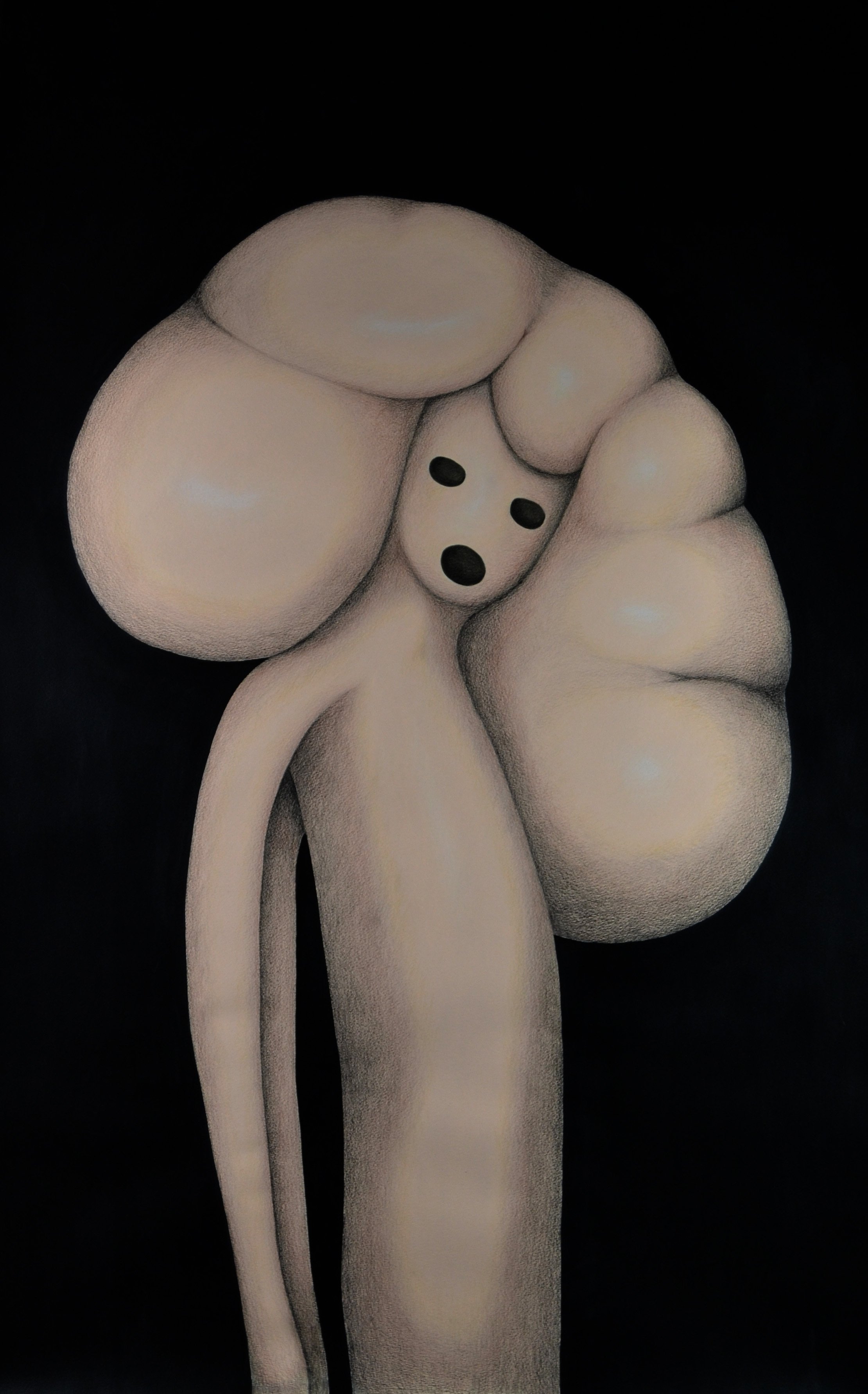Rosalía Banet
Rosalía Banet is a multidisciplinary artist, whose practice always starts from drawing, to develop projects that take different forms and formats, from paintings or sculptures to installations and audiovisual pieces. For some years her artistic practice has been based on the search for sustainable development.
PhD in Fine Arts from the University of Vigo, in her doctoral thesis she approached the mark left by AIDS in Spanish art, through the wounded body, one of the fundamental themes in her career. Through her work, she analyzes and reflects on the systems and patterns we inhabit, from the territory of the body and its diseases, food, the consumer society and the relationship with nature.
Banquete Dorado y Banquete Rosa. They say that the Roman emperor Gaius Caesar, better known as Caligula, in an attempt to demonstrate his power, ordered what would be the most expensive and luxurious banquet to be served: a banquet whose food had been made entirely of gold; a spectacular and irresistible, but inedible banquet.
Centuries later, in Austria, Empress Elizabeth of Bavaria, known as Sissi, who is said to have suffered from anorexia and bulimia, also covered her table with this precious metal: she commissioned large centerpieces, platters, and cake holders. of gold, with which he filled enormous tables and his sick mind, but whose interior hardly housed food.
They are two medium-format sculptural works that work independently, but that, presented together, add up and complement each other. They represent gluttony, excess, hunger, dissatisfaction, malnutrition, poison, food, power, money, toxic, disease, manipulation, spectacle, viscera, garbage.
The two works are a reflection on the current food system, an unsustainable and marginalizing system, with serious consequences at an individual, social, economic, political, environmental and, of course, nutritional level.
All the pieces that appear in the two banquets have been made with plastic resin, as it is a resin of great hardness and resistance and, at the same time, an ecological resin.
The golden banquet is composed, as its name suggests, of golden foods. Thus, they refer to the spectacular, to the brilliance that dazzles and captures us, that blinds us, but under whose skin there is nothing. They are edibles that fill our mind but do not nourish our body.
The pink banquet takes its color from the pink slime or pink slime whose color is similar to that of chewing gum. This is the low-quality meat from the backbone, rectum, and other intestinal areas from which sausages, nuggets, seafood sticks, etc. are made. This color reference serves to question the quality of the food we consume. Very attractive food but empty in nutrients and love.
Cut outs: Skin flowers. The body is the territory from which we glimpse everything that happens. And, as Bessel Van der Kolk proclaims: The body keeps score. It records everything that happens to us, it is marked by the trace of events, they are organisms in constant transformation, reinterpreted over and over again in search of making sense of their finiteness, showing their vulnerability and uncertainty.
Cut outs arise from the investigation of paper as a primary element or construction material. The pieces are a hybrid that combines drawing, painting and sculpture. They are made with silhouettes of cut paper painted with acrylic, but they are not understood as a collage, because although their elements come together to compose new forms, they do not compose a purely two-dimensional piece, since some of their parts separate and create shadows and volumes, others hang, others overlap and clutter almost blatantly.
The silhouettes correspond to body fragments of different shapes and colors that come together to compose a collection of rare flowers, a kind of human flowers. This union is related to multispecies intertwining and the concept of symbiosis. A return to Nature, an invitation to merge with it.
At the same time, this encounter between bodies speaks of diversity. Origins, ethnic groups, shapes and volumes, genres, everything merges into a single body, a global being that breaks physical barriers and composes a deep and almost vital exchange. Skin to skin, a claim and almost a declaration of intent in the times of the digital age.
The pieces will have different sizes, and will be displayed forming a kind of cabinet. They will be presented within showcase frames. Boxes with windows that carry a precious gift inside, perhaps a porcelain doll or an orchid or other delicate and strong flower. A precious flower to treasure.
BIO
Rosalía Banet (España, 1972)
In her career stand out individual exhibitions such as: Beefcake (1999), Looking for Love (2001), Eat Me, Eat Me (2004), and Carnicería Love (2008), all held at the Espacio Mínimo Gallery in Madrid. Wedding Day (2001) at Catherine Clark Gallery, San Francisco (USA). Las Golosas (2009) at the La Conservera Contemporary Art Center (Murcia). Edible Eaters (2013) at the Embarcadero Palace, Santander. Cartographies of Pain (2013) and Dysmorphic Constellations (2015) at Twin Gallery, Madrid. Sweet and Sour Canning Factory (2015) at the Santander Museum of Contemporary Art (MAS). Affliction (2017) at the Alcobendas Contemporary Art Center, Madrid. Gula (2019) at the DKV exhibition hall in Zaragoza. SlowWorld (2021) at the Giménez Lorente Foundation, in Valencia. Irregular (2022) at the Rafael Pérez Hernando gallery, Madrid.
She has participated in relevant collective exhibitions such as: VAC (2006) at IVAM (Institute of Modern and Contemporary Art of Valencia). Madrid-Berlin, Visibility conditions. Künstlerhause Bethanien, Berlin Nit Thread (2007), Koroska Gallery of Fine Arts, Slovenj Gradec (Slovenia) Apart World (2009) and Everything I loved was part of you (2010), at the Instituto Cervantes, Madrid From paper to reality (2011) At the ABC Museum, Madrid Them and us (2017) at Es Baluard Contemporary Art Center, Mallorca Processi 144 (2017) at the Royal Academy of Spain in Rome*/Matadero, Madrid Parenthesis Stories from uncertainty (2021), traveling exhibition through Latin America Bread and Circus (2022) at the Conde Duque Center for Contemporary Culture, Madrid. And international fairs such as: ARCO (Madrid), Art Lima, PINTA Art Fair (London), FEMACO (Mexico), CIGE (Beijing), Volta 01 (Basel), Frieze (London), Art Chicago, Art Miami, Artísima (Turin) or Swab (Barcelona).
She has received prestigious international awards such as: Scholarship from the Royal Academy of Spain in Rome (2016/17) Artist residency at Casa de Velázquez (Academy of France in Madrid, 2018) Artist residency at HIAP (Helsinki International Artist Programme, 2019).
She has works in relevant collections such as: Coca-Cola Foundation, Community of Madrid (in the CA2M center), IVAM (Valencia Institute of Modern and Contemporary Art), MAS (Santander Museum of Contemporary Art), Luis Coromina Foundation (Barcelona) , Generalitat Valenciana, Diputación de Pontevedra, Fundación Unicaja (Málaga), Collection DKV, or the Collection Pilar Citoler.



















































